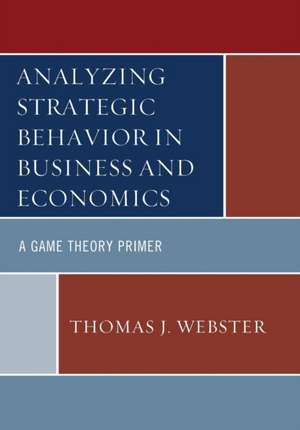Analyzing Strategic Behavior in Business and Economics
Autor Thomas J. Websteren Limba Engleză Paperback – 28 sep 2015
Preț: 437.96 lei
Nou
Puncte Express: 657
Preț estimativ în valută:
83.80€ • 87.50$ • 69.36£
83.80€ • 87.50$ • 69.36£
Carte tipărită la comandă
Livrare economică 04-18 aprilie
Preluare comenzi: 021 569.72.76
Specificații
ISBN-13: 9781498525626
ISBN-10: 1498525628
Pagini: 286
Ilustrații: 366 black & white illustrations
Dimensiuni: 175 x 251 x 18 mm
Greutate: 0.64 kg
Editura: Rowman & Littlefield
ISBN-10: 1498525628
Pagini: 286
Ilustrații: 366 black & white illustrations
Dimensiuni: 175 x 251 x 18 mm
Greutate: 0.64 kg
Editura: Rowman & Littlefield
Notă biografică
Cuprins
PREFACE
1 INTRODUCTION TO GAME THEORY
Introduction
Strategic behavior
Short history of game theory
Lexicon of game theory
Rational versus actual behavior
Practice Exercises
PART I: STATIC GAMES WITH COMPLETE INFORMATION
2 COALITION GAMES
Introduction
Prisoner¿s dilemma The extensive form The normal form
Nash equilibrium Shortcut for finding-pure strategy Nash equilibria Determinants of business collusion Number of firms with similar interests Firm size relative to the industry Visibility
Practice Exercises
3 STRATEGIC MOVES AND DETERRING DEFECTION Introduction Strategic moves
Deterring defection Contracts Reputation Cutting off communications Preventing retreat Brinksmanship Incrementalism Teamwork Agents
Practice exercises
4 COMPETITION GAMES
Introduction
Strictly-dominant strategies
Weakly-dominant strategies
Iterated elimination of dominated strategies
Three-player games
Non-dominant strategies
Maximin (secure) strategy
Practice exercises
5 COORDINATION GAMES
Introduction
Battle-of-the-sexes game
Focal-point equilibrium
Developing a theory of focal-point equilibria Framing
Practice Exercises
6 INFINITELY-REPEATED GAMES
Introduction
Coalitions
Repeated static games
Trigger strategies
Evaluating payoffs in infinitely-repeated games
Practice Exercises
7 FINITELY-REPEATED GAMES
Introduction
Finitely-repeated games with a certain end End-of-game problem
Finitely-repeated games with an uncertain end A word of caution
Concluding remarks
Practice Exercises
8 EVOLUTION GAMES
Introduction
Evolutionary game theory
Reproductive success
Evolutionary equilibrium
Networks Positive feedback effects Network game Implications Practice Exercises
9 TIT-FOR-TAT
Introduction
Tit-for-tat
End-of-game problem
Practice Exercises
10 MIXING PURE STRATEGIES
Introduction
Zero-sum games Matching pennies
Minimax theorem
Mixed strategies
Optimal mixing rules
Calculating optimal mixing rules
When to use optimal mixing rules
How to use optimal mixing rules
Bluffing
Practice Exercises
11. CONTINUOUS STRATEGIES
Introduction Continuous strategies Best-response (reaction) functions Tragedy of the commons Shifting best-response functions Practice Exercises
12. STATIC OLIGOPOLY GAMES
Introduction
Cournot model Advertising in a Cournot setting
Bertrand model Bertrand paradox
Practice Exercises
13. STRATEGIC TRADE POLICY
Introduction Discrete pure strategies Continuous pure strategies National welfare Intraindustry trade Imperfect competition Intraindustry coalitions Export subsidies Reciprocity Practice Exercises
14. PRODUCT DIFFERENTIATION
Introduction
Horizontal differentiation
Vertical differentiation Location Product differences
Practice exercises
15. STRATEGIC COMPLEMENTS
Introduction
Double marginalization
Practice exercises
PART II: DYNAMIC GAMES WITH COMPLETE AND PERFECT INFORMATION
16. GAME TREES
Introduction
Game trees
Subgame perfection
Backward induction
Credible threats
First-mover advantage Entry deterrence
Practice Exercises
17. A DYNAMIC OLIGOPOLY GAME
Introduction
Stackelberg model
Practice Exercises
18. BARGAINING
Introduction
The bargaining problem
Ultimatum bargaining Ultimatum paradox
Nash bargaining
Rubenstein bargaining
Last-mover¿s advantage
Symmetric impatience
Asymmetric impatience
Practice Exercises
PART III: GAMES WITH INCOMPLETE INFORMATION
19. DECISION MAKING AND UNCERTAINTY
Introduction
Risk and uncertainty
Static games with uncertain payoffs
Static games in extensive form
Dynamic games with uncertain payoffs
Attitudes towards risk
Risk aversion
Understanding risk-averse behavior
Practice Exercises
20. ADVERSE SELECTION
Introduction
The market for lemons
Practice Exercises
21. INCENTIVE CONTRACTS
Introduction
Principal-agent problem
Incentive contracts Principal-agent problem with moral hazard
Practice Exercises
PART IV: GAMES WITH IMPERFECT INFORMATION
22. INFORMATION SETS
Introduction
Information sets
Bayesian updating
Practice Exercises
23. AUCTIONS Introduction
Types of auctions
Information structures
Complete-information auctions Sealed-bid, first-price auction Sealed-bid, second-price auction English auction Dutch auction Expected revenues from complete-information auctions
Incomplete-information auctions with independent private values Sealed-bid, first-price auction Sealed-bid, second-price auction English auction Dutch auction Expected revenues from incomplete-information auctions with independent private values
Incomplete-information auctions with correlated value estimates Common-value auctions and the winner¿s curse
Incomplete-information auctions and risk aversion
Practice exercises
24. SIGNALING
Introduction
Spence education game Pooling strategy Separating strategy
Corporate investment game
Multiple subgame-perfect Bayesian equilibria
Practice Exercises
25. SCREENING
Introduction
Self-selection
Spence education game in reverse
Practice Exercises
APPENDICES
REFERENCES AND SUGGESTIONS FOR FURTHER READING
INDEX
Descriere
This innovative textbook is a concise and axiomatic introduction to the principles of game theory--the formal study of move and countermove. Undergraduate business and economics students with a background in the principles of microeconomics and college mathematics will find the material presented in this textbook focused, comprehensive, and accessible.
